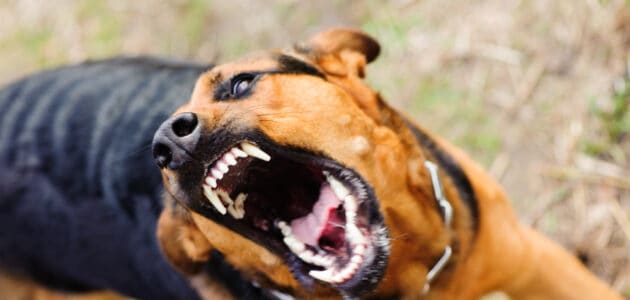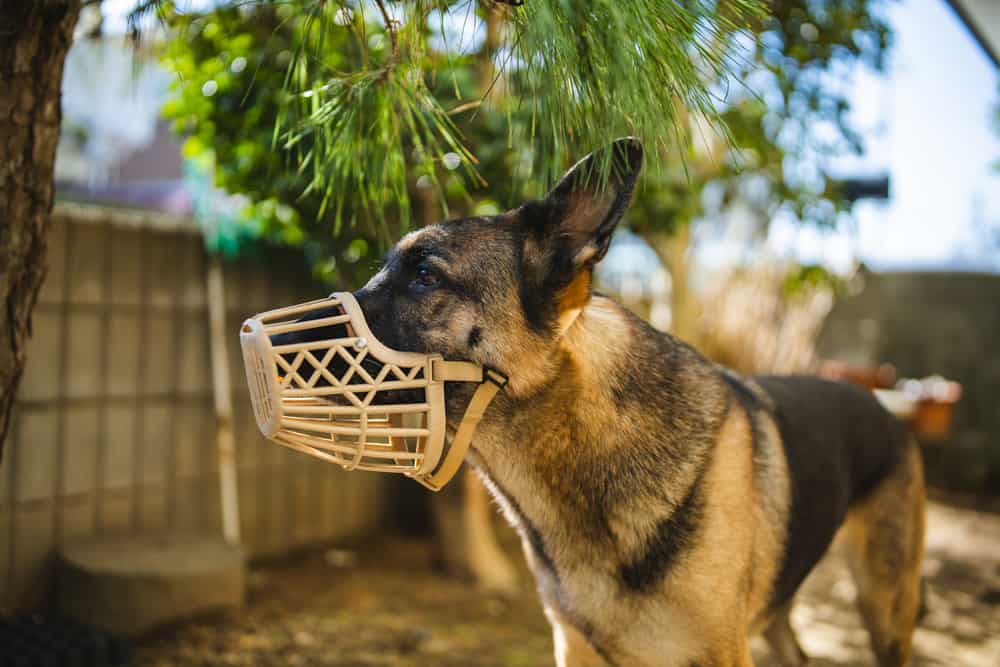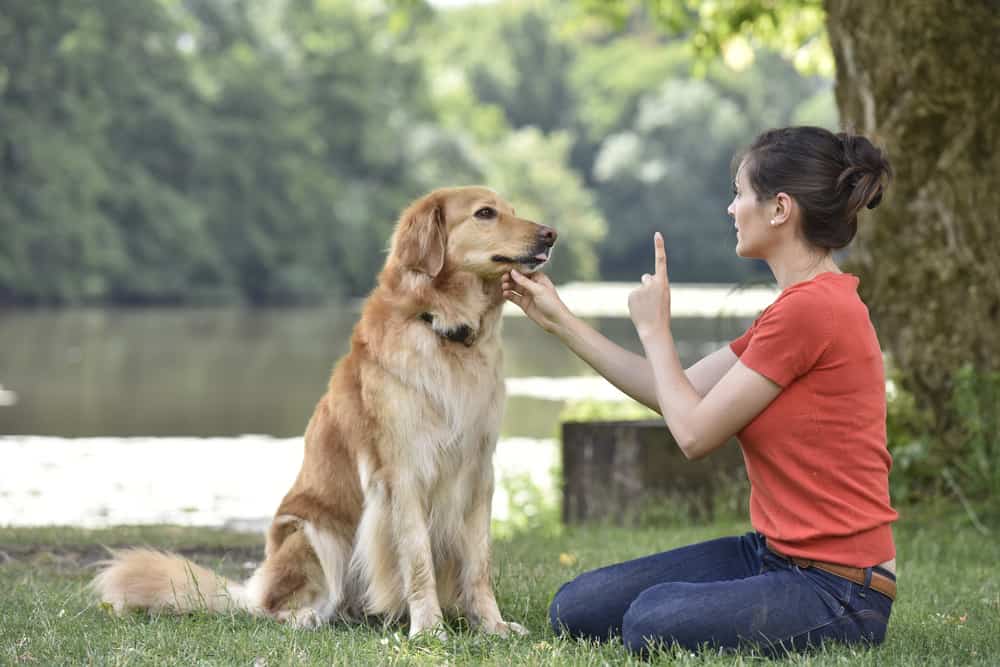What to Do if Your Dog Gets Into a Fight

Just like people, dogs don’t always get along. Sometimes, we already know that a dog has aggressive tendencies, but other times it comes as a shock. Either way, dog fights are scary, and they can be dangerous to both dogs and owners alike. That’s why it’s so important to take the initiative to prevent fights and improve behavior in aggressive dogs.
Dealing with aggression takes a lot of dedication from the owner, but it’s worth it. Your dog will feel more comfortable around other dogs, and you will not have to worry about the tragedies that can result from dog fights.
It’s important to understand that once your dog has gotten into a row, you need to come up with a plan to improve her behavior so it doesn’t happen again. Sometimes, this involves a number of steps and repeated training. Simply disciplining a dog immediately after a fight is not enough, nor is it a good idea. Let’s talk about why.
Don’t Use Punishment for Aggressive Behaviors
Before we can explain how to address aggressive behaviors in dogs, we have to talk about discipline. Many people think they should discipline their dogs, either through scolding or even physical punishment, but punishing your dog when she shows aggressive behaviors is one of the worst things you can do.
Dogs use both body language and vocal cues to communicate with one another, growling and snarling included. If you scold your dog for growling or any other such posturing, you’re actually discouraging this kind of communication. Through this communication, your dog lets others know she is on the offensive, and they better stay away.
If you scold your dog for these behaviors, she may stop giving such warnings altogether. Then, when a dog invades her space or goes after the resource she is guarding, she’ll attack seemingly out of nowhere. However, she has actually been taught not to display these natural behaviors that serve as a warning and inhibit many dog fights.
Identify the Triggers
There are different situations in which dog fights can occur. It can be between your dog and a random dog or between dogs in your own household. In either case, you need to pay close attention to your dog and look for a pattern. What seems to be the reason your dog is becoming aggressive?
Their Place in the Hierarchy
Dogs that live together have somewhat of a pecking order. It’s difficult to call this a hierarchy because it is not so straightforward. A dog may be competitive for food but submissive to others when it comes to toys. Still, if you can figure out which dog is the assertive one in any given situation, it will help you prevent fights.
Possessiveness
Does your dog always get aggressive toward others in the house when food is around? What about toys? What about your own attention? You need to figure out the triggers for your dog’s behavior in order to address it.
Specific Triggers
Similarly, for dogs that are aggressive toward others outside of the household, you need to watch for patterns. Is there a specific color or breed of dog your dog is aggressive toward? Is your dog only aggressive during certain interactions like greetings? What does your dog’s body language look like?
Anxiety
Often, dogs can lash out because they are fearful and anxious. Dogs that are fearful growl with their lips pulled back toward their ears, exposing more of their teeth. They also tend to be wide-eyed and may exhibit other fearful body languages, such as a tucked tail.
Telling You to Back Off
On the other hand, confident dogs that are on the offensive growl with their lips pushed forward. Their bodies are standing tall and stiff, tails are not tucked, and they may even appear to have their weight shifted forward. These dogs are not acting up out of anxiety, but they are letting you know to back off.
Are You Part of the Problem?
In some cases, a dog owner’s actions can make the problem worse. This is especially true when aggression is occurring between dogs in the same household.
As humans, we know life isn’t fair, but we believe it should be. Because of this, we’ll often step in when one dog hogs a toy or steals it from the other dog. Often, we’ll take it away from the hogger and give it to the other dog.
What we don’t realize is that the dogs have already worked out this problem amongst themselves. One dog has laid claim to the toy, and the other has deferred to her. The latter dog is considered submissive in this instance, and it is this willingness to defer that keeps the two dogs from fighting over the toy.
The submissive dog would much rather wait her turn or get an entirely different toy than get in a fight over it. Depending on how you interfere, you can cause a whole slew of issues. Your interference may lead to the assertive dog feeling the need to challenge the submissive one, whereas before, no challenge was necessary.
You may embolden the submissive dog to go after resources she normally wouldn’t because she now feels protected by your presence. The typically assertive dog may not want to share or give up the resource regardless of your interference, and it can lead to a fight.
Be careful that you don’t intervene in your dogs’ communication with one another. Sometimes, they already have things figured out between them.
How to Prevent Your Dog Fighting
Once you’ve identified your dog’s triggers and determined if your own interference is part of the issue, you can move on to prevention.
Be Aware of Your Dog’s Triggers
Knowing what sets your dog off will help you prevent future incidents.
For instance, if your dog gets aggressive at dinner time, you may choose to feed your dogs in completely separate rooms. If you hope for them to eat in the same room, place their dishes far apart. For added security, you can leash them and either attach them to heavy furniture or have someone holding onto the leashes so that the dogs cannot approach each other’s dishes.
Reward and Redirect
Part of prevention is also rewarding behaviors you want to see and redirecting those you don’t. In the instance of a dog guarding her dinner from other dogs, you should not encourage any dog toward the other’s food dish.
If one dog begins to approach the other’s dish, and you believe this is likely to cause a fight, try redirection. Call the dog to come to you instead, or teach it to go to a specified area after eating.
You can also teach your dogs that you are the giver of all resources and that to get those resources they must behave in a certain way. For instance, each dog must be sitting or lying calmly in their designated areas before they will be given food. Unruly behavior means they won’t get what they want.
Avoid Triggers When Outside
Prevention for dogs who are aggressive toward dogs they don’t live with may involve taking walks in areas without much animal traffic, using head collars or muzzles (more on that in Tools), and walking the opposite direction when you see other dogs coming toward you.
Obedience Training
Obedience is an important part of prevention. Having control over your dogs will help you reduce the likelihood of fighting.
Use the “Go to” Command
When tensions are rising, you can send the submissive dog away with a “go to” command (“go to your mat”). This will appear as a retreat to the assertive dog and should calm both down. Just make sure that the submissive dog does not have to pass in front of the assertive one to follow your command.
Have Your Dog Come to You
Similarly, you can redirect the assertive dog by having it come to you (but make sure to keep distance between the two dogs). After that, a sit and stay command can also be useful. The idea is that instead of going after the other dog, your dog comes to you and gets rewarded.
Work on Obedience at Home Even if the Triggers Are Outside
For dogs who have aggressive tendencies outside of the home, obedience is still important. You want your dog to be listening and paying attention to you so that you can show your dog what to do in uncomfortable situations.
Have Your Dog Look at You
“Watch me” or “look at me” commands are helpful for getting your dog’s attention and letting her know she should focus on you. Sometimes, just having your dog look at you instead of other dogs is enough.
Otherwise, you’ve now got your dog’s focus and can show her what she should be doing while other dogs are in view. Practice with your dog while other dogs are still far away, and put distance between yourself and others before it becomes an issue.
Use Positive Reinforcement
When working on obedience training, be sure to use positive reinforcement methods. You want your dog to learn that listening to you is fun and rewarding. This will motivate her to obey.
Tools

You may want to use some tools to keep everyone safe.
Head Collar
You should consider using a head collar on both dogs, especially when they are in situations that trigger them.
A head collar is kind of like a halter but for dogs. By attaching a leash to it, you have control over the movement of the dog’s head. It also makes it much harder for the dog to pull, so you’ll be able to inhibit her from lunging as well. Not only do you have more control, but head collars also tighten around the dog’s snout and keep her mouth closed when the leash is taut.
Basket Muzzle
Depending on how severe the problem is, you may consider using a basket muzzle. This type of muzzle does not hold your dog’s mouth closed, so it is more comfortable. It does, however, create a barrier that prevents your dog from biting others. You can also offer treats through the openings in order to reward your dog for good behavior.
Counterconditioning and Desensitization
Prevention is important and it’s necessary if your dog isn’t completely obedient. However, depending on the situation, it may not be practical to use prevention methods for the rest of your dog’s life.
What Is Counterconditioning?
When possible, you’ll want to counter-condition your dog. This means that whatever triggers your dog, you want to condition her to have a different, positive response to that stimuli. Counter-conditioning is all about desensitizing your dog so that she no longer reacts to a trigger with fear or aggression.
The basics of counter-conditioning involve exposing a dog gradually to a stimulus while offering positive reinforcement through rewards like high-value treats or toys. The dog will notice that good things happen while the stimulus is present, eventually learning that the stimulus is not a threat.
What Type of Dogs Is Counterconditioning Good For?
We see counter-conditioning used a lot in cases of dogs that are anxious and fearful. They’re aggressive because they’re afraid, so teaching them not to be afraid can make all the difference.
We’ve talked a lot about dealing with aggression between dogs living in the same household, but counter-conditioning is useful for treating dogs that react aggressively to stimuli outside of their homes as well as for dogs that share a home.
Breaking up a Dog Fight
We’ve talked about prevention, obedience, and desensitization, so we hope that you’ll be able to avoid any dog fights. However, the unexpected can certainly come to pass, so it’s important to know what to do in the event of a dog fight.
First of all, don’t try to use any part of your body to get between two fighting dogs. You are very likely to get bitten. Even if your dog is an angel who cuddles up with you every night, in the heat of a fight, she’s not going to notice that the hand in her way is yours.
Instead, there are a few things you can try to break up a dog fight.
1. Make Loud Noises
Sometimes, loud noises can distract dogs enough that they will stop fighting. We suggest clanging the lids of pots together. Yelling is not a good idea; it’s not likely to work and may even add fuel to the fire.
Loud noises can also be a great way to prevent a fight that is about to happen. If you see stiff-bodied dogs staring intensely at one another, clang some pans together, and they’re likely to lose focus and move on.
2. Put an Object Between Them
When two dogs are fighting, slamming an object in between them can sometimes break things up. You’ll want to use a large object like a garbage can. Doggy daycare centers often have large rectangular boards used for this purpose (and you can likely buy something similar online). Even a broom or mop can work. As always, be careful not to put yourself in harm’s way.
3. Pull Them Apart
If you’re out on a walk and your dog gets into a fight, you won’t have any of the tools mentioned previously. In this situation, focus on removing the aggressor first, as the other dog is likely to give up once the aggressor has been removed.
There are two safe ways to do this.
- The first is to use a leash. If your dog is the aggressor and you have hold of her via a leash, use it to pull her away. If you know your dog is aggressive, walk her using a muzzle or a head collar like the Gentle Leader. As we explained, tension on the leash will cause the nose strap on the head collar to tighten and force the dog’s mouth shut.
- The second option is to grab the dog by its back legs. This is called the wheelbarrow method. Often, dogs will let go the moment their back legs leave the ground, but if not, you can physically pull the dog away by its legs. By grabbing the back legs, you prevent yourself from getting bitten.
It may be tempting, but you should avoid grabbing a dog’s collar. This increases your risk of getting bitten.
4. Spray Them With Water
If the fight happens to occur in someone’s front yard, grab the hose and spray the dogs with water. This is often an effective method that snaps dogs out of fight mode.
Since you won’t always have a hose handy, you can carry citronella spray. Dogs find the scent aversive, so it can sometimes be enough to stop a fight. However, these sprays aren’t always effective when dogs are too worked up.
Seek Professional Help

While our article can help you understand the basics of what can be done to address dog fights, we suggest you seek the help of a certified animal behaviorist or trainer. A professional can help you identify the root of the problem and come up with a step-by-step plan to address it.
Furthermore, you can ask them questions about your specific issues, whereas our article can only be considered a general guideline. A professional can help you deal with your dog’s aggression safely and efficiently.
In the worst-case scenario, a professional can also provide realistic expectations. In cases where aggression is occurring between members of the same household, especially when both members are assertive and neither is willing to defer, sometimes rehoming needs to be considered for everyone’s safety.
Use These Tips to Help Your Dog After Fighting
Dealing with aggression is a stressful experience for dog owners. We don’t want our dogs to get hurt or hurt other dogs, and we often feel overwhelmed with not knowing how to deal with the problem. It’s important to stay calm so that you can take control of the situation.
Identify what triggers your dog’s aggression and use tools like head collars and muzzles to your advantage. Work on preventing situations that could cause fights and spend extra time on obedience training.
Counter-conditioning and the aid of a professional animal behaviorist can help resolve aggressive tendencies. With dedication and a positive approach, you can prevent fights and even improve upon aggressive behaviors.




